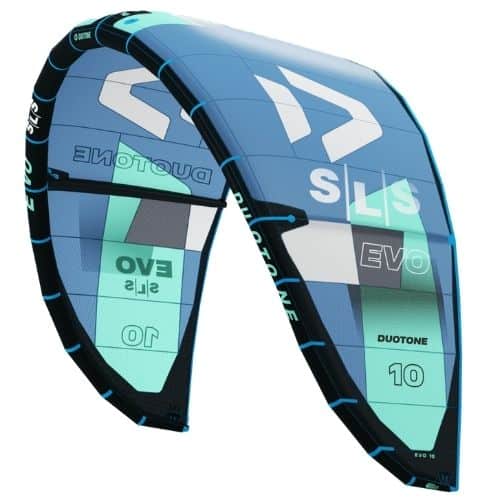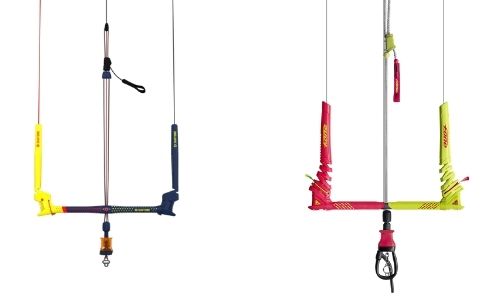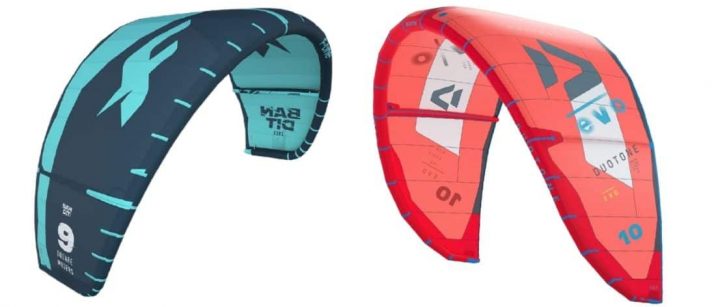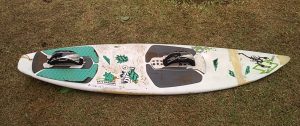Both the Duotone Evo and the f-one Bandit are great kites. They’re marketed as all-around, general kites for people looking for a single versatile kite for different riding styles and conditions. However, these two kites fly differently and have significant differences in their bar and line setups.
Overall, the Evo is better for beginners and for higher jumps and hangtime, whereas the Bandit is a faster, more agile kite designed for all levels of kiter, with good performance across a wide variety of disciplines including wave riding and foiling.
While the Evo may be easier to handle for beginners who are doing basic riding and jumps, for riders who are already comfortable with a kite, the f-one will give better performance and more flexibility with different riding styles.
Here’s a rundown of which of the Evo or Bandit wins for the different flying capabilities:
| Capability | Duotone Evo | F-one Bandit |
|---|---|---|
| Ease of use / learning | ||
| Grunt |  | |
| Depower |  | |
| Relaunch |  | |
| Upwind |  | |
| Low end |  | |
| High end |  | |
| Boosting |  | |
| Hangtime |  | |
| Turning / wave |  | |
| Drifting |  | |
| 5th line effectiveness |  |
If you’re wondering which of these two kites is best for you, let’s take a closer look at how these kites differ in terms of features, capabilities, and bar and line functions.
Bandit vs Evo: overview
Duotone has classified the Evo not only as a freeride/freestyle kite, but also as a beginner kite. Because it’s so forgiving and easy to use, it’s a good choice for someone who doesn’t have a lot of experience yet and is primarily looking to ride around and jump.
Despite being entry-level, however, the Evo is still noted for its performance in terms of lift, hangtime, stability, and range.
The Bandit has long been promoted as a versatile kite, suitable for all levels and riding styles. With its fast and smooth turns, predictability, and direct power response, skilled kiters as well as beginners can enjoy this kite.
Under constant development for 14 years, the Bandit enjoys a reputation for delivering great performance in all areas, without sacrificing performance in any particular one.
Bandit vs. Evo: Similarities
Both the Evo and the Bandit are 3-strut kites based on a delta shape, which gives stability, ease of use, and good relaunching ability.
Both have back-line connection points that end in loops, which brings the center of effort forward on the kite when sheeting out. These loops can be adjusted to set the turning characteristics (fast or slow) and bar pressure (low or high).
Both use a pulley and cleat depower system, with a high-V single-line flag out as the primary safety system when the quick release is activated.
The quick-release mechanism is similar on these two models too, with a push-away activation that requires two hands to reattach.
And both have a wide diameter, high-volume inflate/deflate valve with a center pin to lock the valve open or closed (standard on most kites now).
Specialty versions: Evo SLS and Bandit S2

The Evo and the Bandit are also offered in lighter, specialized high-performance versions.
The Evo SLS (“Strong Light Superior) is 15% lighter than the regular Evo. With its lighter construction and thinner bridles and struts, it’s designed for lighter air and more extreme riding.
The SLS is more reactive than the regular Evo, with faster turns and acceleration, and designed to get higher air.
In 2019, f-one introduced the Bandit S2, a dedicated strapless and surf kite, to complement the standard Bandit range. As with the Evo SLS, it’s made with lighter materials and construction.
The S2 is designed to give better handling, agility, and instant depower for more advanced riders in waves.
Bandit vs. Evo: turns, stability, hangtime
Although the Evo and the Bandit are both delta kites, the differences in the way they fly are due mostly to the Evo’s slightly higher aspect ratio, and its static bridle (no pulleys).
The higher aspect ratio gives the Evo a larger steering arc and faster forward motion. But it’s also slower in the turns and loops, and not as responsive as the Bandit.
For kiters who are most interested in freeriding and are looking for higher jumps, more hangtime, and easier upwind, the Evo will beat out the Bandit.
For fast turns, aggressive freestyling and megaloops, the Bandit is superior. It’s also better for wave riding and unhooked tricks than the Evo, with better drift and tighter powered turns.
The static bridle on the Evo means that the bar needs to be moved a bit further out to depower, and there is a bit more bar pressure.
The Bandit, with its rounder shape, will also be slightly easier to tip over onto its side to relaunch, especially in lighter winds.
If you are a beginner, you might not be able to easily identify the differences in how the two kites fly. In fact, changing the back line attachment settings on either kite may change your feeling of the kite even more than switching between models.
That said, the differences between the kites become more apparent when you look at the bars and lines, with their different configurations and options.
Bandit vs Evo: construction
The f-one bandit has a lighter and simpler construction. One place where this is apparent is on the one-pump system.
A quick look will show that the one pump system on the Duotone is more robust, with thicker covers, valves, tubes, and a reinforced valve cover with a click-on attachment system.
The Bandit has thinner valves, with the tube secured only by a small ring. This makes the f-one bladder easier to remove for bladder replacement (requiring no tools), but more fragile than the Evo.
The Evo bridle has six attachment points to the kite on each side; the Bandit has four.
The Evo also has battens in the trailing edge, and thicker leading edge ends at the wingtips to reduce flutter.
Bandit vs Evo: power & wind range
Here are the wind ranges for each kite size for both the Evo and the Bandit:
| Kite size | Duotone Evo | F-one Bandit |
|---|---|---|
| 4m | 25 – 43 kn | |
| 5m | 23 – 41 kn | |
| 6m | 21 – 40 kn | |
| 7m | 19 – 37 kn | 25+ kn |
| 8m | 17 – 35 kn | 20 – 35 kn |
| 9m | 15 – 33 kn | 15 – 30 kn |
| 10m | 13 – 31 kn | 12 – 26 kn |
| 11m | 12 – 28 kn | 11 – 24 kn |
| 12m | 11 – 26 kn | 10 – 22 kn |
| 13m | 10 – 24 kn | |
| 14m | 9 – 22 kn | 8 – 18 kn |
In the smaller sizes, the Evo has better low end power; the smaller Bandits are meant to be flown more powered-up and need more wind for the same kite size. In the bigger sizes (11m and up), the Bandits have better power at the lower wind range.
The Bandits are designed with different flying characteristics and wind ranges depending on the size of the kite.
Evo vs Bandit: bar and control system

Both the “Trust” bar that comes with the Evo, and the “Linx” bar that comes with the Bandit, have built-in adjustors for back line lengths. They also both have the ability to change the back line attachment points to effectively change the bar size.
The depower systems have slightly different designs, however. The Bandit Linx bar has a single, thick, covered depower line, while the Evo Trust bar has a double, thinner, unsheathed depower line which slides more easily along the bar.
A nice feature on the Evo’s Trust bar is the ability to adjust the amount of “throw” by changing the point where the depower cleat attaches along the depower line. Kiters with shorter arms will appreciate this.
On the Bandit bar this isn’t possible as the cleat is fixed on the depower line.
The Trust bar is offered in four line lengths: 19m, 22m, 24m and 27m. The Linx bar only comes in 21m and 24m options. Neither has detachable pigtails or removable line segments, which makes it more difficult to change your line lengths.
On the f-one bar, all four line ends are loops, with knots on the kite side for attaching. The Trust bar has the “kook-proof” setup to help avoid mistakenly switching the front and back lines.
The Trust bar gives four different chicken loop size options, for wakestyle, freestyle, freeride, or rope harness setup, while the Linx bar has only two.
5-line options
Any Duotone Trust bar can be fitted with a 5-line option, while only the smallest size f-one bar (the 42/35cm, marketed as the dedicated “freestyle” version) comes with 5 lines.
A five-line system offers a more instant and complete flagout in case of quick release activation, and easier relaunch in light winds.
If your kite is nose-down on the water, using the fifth line to tip the kite over makes it easier to catch the wind in the tip and bring it to the edge of the window for relaunch.
A kite that is easier to relaunch becomes a good candidate for a light-wind kite. So if you plan to use a bigger kite in light winds, whether for foiling or not, the Evo may be better for you.
The downside of having a fifth line is that there is one more line that can get tangled. And if the kite inverts, then the fifth line can get wrapped around the kite.
Evo vs Bandit: summary
The Evo and the Bandit fly a bit differently and have significant differences in their bar setups. The Evo is slightly more specialized and beginner-oriented, whereas the Bandit is designed for all levels of kiter, with good performance across a wide variety of disciplines.
Keep in mind that impressions of kites are very subjective and depend on each rider. Also, kite designs change from year to year, and even between different sizes. Ultimately, the only way to know for sure is to rely on your own observations and feelings.



